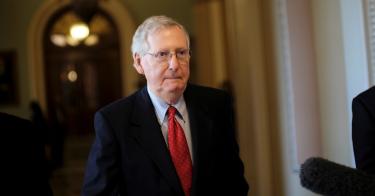Obamacare’s individual mandate to buy federally standardized health insurance is a tax, courtesy of the Supreme Court’s elaborate exercise in creative writing: National Federation of Independent Business v. Sebelius (2012).
Legislators should judge a law by its results, not by good intentions. The record is clear: This particular tax is both unworkable and unfair. The Senate’s decision last week to repeal it is thus sound policy.
The individual mandate tax is not working. Its policy objective is to increase enrollment in private coverage and deter un-insurance.
To accomplish this goal, the law says that any person who does not buy an Obamacare plan would pay an annual tax penalty equal to 2.5 percent of their household income or $695, whichever amount is greater.
The penalty extends to families, including an annual penalty of $347.50 for any child under the age of 18 with a maximum annual family penalty of $2,085. Penalties increase annually by the rate of inflation.
Consider the incentives. Those who insure must buy Washington’s standardized insurance products, whether they like them or not, where premiums for standard plans this year have increased—not by the simple rate of inflation, but by 25 percent on average nationwide.
Before their coverage kicks in, consumers are faced with deductibles this year that average $3,572 for single persons and $7,474 for families in the standard (“silver”) plans. If consumers instead buy the “cheapest” (“bronze”) plans on the exchange, they face an average deductible of $6,092 for single coverage and $12,383 for family coverage.
For millions of middle-class families, this is the equivalent of a second mortgage payment.
Incentives under current policy are therefore perverse. Paying the mandate’s tax penalties (and relying on hospital emergency room care if necessary) may be wrong or unwise, but it is a lot cheaper than forking over the big premiums and crazy deductibles.
Kaiser Family Foundation researchers estimated that persons without mandatory coverage in 2016 faced an average penalty of $738 per household, while upper income persons (legally ineligible for insurance subsidies) faced an average penalty of $1,450.
Obamacare’s Medicaid expansion is responsible for coverage increases, not mandate-driven private insurance. Most who buy “private” Obamacare coverage on the exchanges—more than eight out of 10 enrollees—get enormously generous taxpayer subsidies for insurance. They are not quaking in fear over the threat of mandate penalties.
Coverage considerations are important. In its latest contribution, the Congressional Budget Office estimates that, over the next 10 years, repeal of the mandate penalty would mean that 13 million fewer persons would have health insurance, including, weirdly, an estimated 5 million Medicaid enrollees who get “free” care.
To their credit, the professionals at Congressional Budget Office have repeatedly acknowledged the profound uncertainties surrounding their estimates on the impact of health policy changes, particularly in recent House and Senate reform legislation.
Let’s take those self-acknowledged uncertainties to heart.
The Congressional Budget Office’s key assumption is that this tax encourages people to buy Obamacare coverage. Logically, one can accept their estimates of future coverage reductions if, and only if, one accepts the their estimates of future coverage.
The problem is that, since 2010, Congressional Budget Office’s coverage projections have been spectacularly wrong. In 2016, for example, they projected 21 million people would be enrolled in the exchanges, but the actual number was roughly 11.5 million.
For 2017, as the White House reports, under Congressional Budget Office projections, there were supposed to be 25 million exchange enrollees—but only about 10.3 million persons enrolled. Not surprisingly, independent academic research also indicates that the mandate penalty has a relatively weak impact on increasing coverage levels.
If the Senate tax reform bill passes, will there be 13 million fewer insured in the next 10 years, as the Congressional Budget Office projects? Or, will it be the far less dramatic 3 to 5 million estimated by the independent analysts with S&P Global?
Who knows? In any case, the Congressional Budget Office’s past predictive performance should inspire no confidence.
A related reason why this tax is unworkable is simply that public officials are not prepared to vigorously enforce it. Based on 2015 data, 6.5 million Americans paid the mandate penalty rather than buy Obamacare’s high-cost coverage, and another 12.7 million were able to take advantage of the various exemptions from the mandate.
Curiously, the tax is also profoundly regressive, falling on middle to lower-income persons least able to absorb reductions in their disposable income. Based on the 2015 data, 79 percent of those who paid the tax penalty had annual incomes less the $50,000, while 37 percent of them had incomes less than $25,000.
Curiously, while campaigning against Hillary Clinton for the Democratic presidential nomination in 2008, Barack Obama himself opposed the individual mandate because he said that it would be unfair and unenforceable: “If a mandate was the solution, we could try that to solve homelessness by mandating everybody buy a house.”
Candidate Obama was right. President Obama was wrong.
Congress could, of course, preserve the mandate and toughen enforcement. While progressive policy analysts may talk privately about getting tough with non-compliant Americans (bulking up IRS enforcement, increasing the penalties, garnishing wages, and so forth), the law’s advocates in Congress have not shown the intestinal fortitude to advance such proposals.
Instead, they are promising more government spending, heavier government regulation, and yet another government health plan—a “ robust public option”—to erode further the already-shrunken choice and competition in the insurance markets.
Meanwhile, it’s absurd for Congress to preserve a law it will not enforce.
The real alternative to a government stick (the mandate tax) is a government carrot (regulatory reform)—a friendlier market environment, free of coercion, and characterized by robust consumer choice and competition; a market where people want to buy an affordable product that they determine is of value to them.
Younger and healthier people should not be discouraged from entering the health insurance market by government policy that limits their options and deliberately drives up their health insurance costs—policy that makes coverage unaffordable and undesirable.
Repealing the individual mandate penalty is sound policy. It is, however, only the first step in a hard process of carefully crafting insurance market reforms and allowing new health insurance markets to flourish—markets where individuals and families will control their health care dollars and decisions.
This piece originally appeared in The Daily Signal




